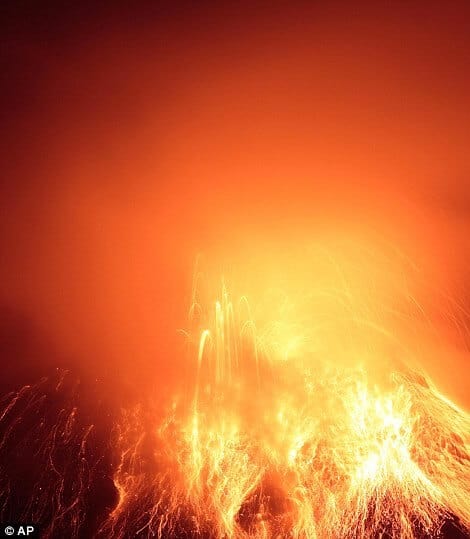The geological record holds clues that throughout Earth’s 4.5-billion-year lifetime massive supervolcanoes, far larger than Mount St. Helens or Mount Pinatubo, have erupted. However, despite the claims of those who fear 2012, there’s no evidence that such a supereruption is imminent.
What exactly is a “supervolcano” or a “supereruption?” Both terms are fairly new and favored by the media more than scientists, but geologists have begun to use them in recent years to refer to explosive volcanic eruptions that eject about ten thousand times the quantity of magma and ash that Mount St. Helens, one of the most explosive eruptions in recent years, expelled.
It’s hard to comprehend an eruption of that scope, but Earth’s surface has preserved distinctive clues of many massive supereruptions. Expansive layers of ash blanket large portions of many continents. And huge hollowed-out calderas – craters that can be as big as 60 miles (100 km) across left when a volcano collapses after emptying its entire magma chamber at once – serve as visceral reminders of past supereruptions in Indonesia, New Zealand, the United States, and Chile.
The eruption of these prehistoric supervolcanoes has affected massive areas. The magma flow of Mount Toba in Sumutra, which erupted some 74,000 years ago in what was likely the largest eruption that has ever occurred, released a staggering 700 cubic miles (2,800 cubic km) of magma and left a thick layer of ash over all of South Asia. For comparison, the quantity of magma erupted from Indonesia’s Mount Krakatau in 1883, one of the largest eruptions in recorded history, was about 3 cubic miles (12 cubic km).
Volcanologists continue to seek answers to many unanswered questions about supervolcanoes. For example, what triggers their eruptions, and why do they fail to erupt until their magma chambers achieve such enormous proportions? How does the composition compare to more familiar eruptions? And how can we predict when the next supervolcano will erupt?
But there’s one thing that all experts agree on: supereruptions, though they occur, are exceedingly rare and the odds that one will occur in the lifetime of anybody reading this article are vanishingly small.
The most recent supereruption occurred in New Zealand about 26,000 years ago. The next most recent: the cataclysmic eruption of Mount Toba happened about 50,000 years earlier. In all, geologists have identified the remnant of about 50 supereruptions, though teams are in the process of evaluating a number of other possibilities.
That may sound like a large number. However, when one group of scientists used the count of all the known supervolcanoes to calculate the approximate frequency of eruptions, they found that only 1.4 supereruptions occur every one million years.
That’s not to say that a supervolcano will occur every million years at regular intervals. Many millions of years could pass without a supereruption or many supervolcanoes could erupt in just a short period. The geological record does suggest supervolcanoes occur in clusters, but the clusters are not regular enough to serve as the basis for predictions of future eruptions.
Scientists have no way of predicting with perfect accuracy whether a supervolcano will occur in a given century, decade, or year – and that includes 2012. But they do keep close tabs on volcanically active areas around the world, and so far there’s absolutely no sign of a supereruption looming anytime soon.



good job…. its like that….
I is comforting to know humanity will be spared a bit longer.